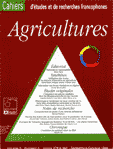À propos de "Tylosema fassoglensis" (Kotschy) Torre & Hillc. : une plante méconnue
Résumé
Many plants with traditional, local uses have not been characterised for nutritional or pharmacological properties. The present note describes the taxonomic, biological, ecological and chemical properties of one of them : Tylosema fassoglensis (Kotschy) Torre & Hillc. The plant seems to be of potentiel use in various areas, mainly nutritional. The Tylosema genus belongs to the tribe of Cercidae Bronn (Caesalpiniaceae). It includes four species, all of which are native to Africa : T. fassoglensis, T. esculentum (Burch.), Schreiber, T. argentea (Chiov.) Brenan, and T. humifusa (Pichi-Serm. & Roti-Michel) Brenan. Their leaves are simple, alternate, bilobate and sometimes deeply divided, and highly cordate. The flowers are yellow, pentamerous, hermaphrodite, and organised into lateral racemes (photo 1). The woody pods usually contain two seeds. T. fassoglensis presents the widest distribution, spreading from Ethiopia to Transvaal and Angola to Mozambique. The other three species are more restricted geographically and live in more arid conditions than those of T. fassoglensis. T. fassoglensis is a tuberous geophyte whose root System may be particularly developped. One of the present authors (MD) recorded a 78-kg tuber (fresh weight) in the sandy soil of Ruzizi Plain (Burundi). The shape of the tuber varies considerably and is hard to describe (photo 2). The aerial shoots are annual and vigorous, with a mean daily growth rate of 2.7 cm. The branching rate is high and the overall length of one year's branch growth may reach 150 m per tuber. The mean leaf area ranges from 38 to 157 cm2 with individual leaf areas reaching up to 10 m2 In Burundi, T. fassoglensis almost behaves like a climbing liana. In other regions, such as Shaba (Zaïre), its habit is prostrate. In Burundi, T. fassoglensis is found in the shrubby savannah of Ruzizi Plain and in the Hyphaene ventricosa Kirk palm grove of Lower-Ruzizi Natural Park (photo 3). In Shaba, T. fassoglensis is mainly found in woodland, under light cover. T. fassoglensis thrives on poor, sandy soil. It tolerates short periods of flooding as well as dry periods. Soil structure did not seem to be a growth-limiting factor to the root System which can tolerate compact soil even when it includes a high proportion of stones. Soil water pH measurments were between 5 and 8. Concerning its chemical composition, we noted lipid and protein levels of approx. 33 and 44 % DM, respectively. The balance between monounsaturated, polyunsaturated and saturated lipids reached 36/36/28, close to the Keys' rule of 33/33/33. At 36 % of total fatty acids, linoleic acid was well represented. The amino acid balance was more or less satisfactory, with fairly high tyrosine and low sulphur-amino-acid levels. Anti-nutritional factors were sought. Phytate and trypsin inhibitors were present at the fairly high levels of 3,5 % and 295 TUI/mg, respectively. A certain amount of information on the traditional uses of T. fassoglensis has found its way into the literature or onto labels. T. esculentum, known as the «marama bean», has long been a major ingredient in the diet of Kalahari populations (seeds and tubers). T. fassoglensis has various other uses : in Kenya, the Masai and Kipsigis make rope from the stems and plaited items from young stems or fibres ; in Burundi, its leaves are used both alongside those of another plant (undetermined) as ichthyotoxic and as fodder for cows and goats ; in Tanzania, Kenya and Burundi, tuber bark and leaves are used in traditional pharmacology. Similarly, T. fassoglensis seeds are eaten either boiled or roasted (photo 4) in Ethiopia, Tanzania, Zaïre and South Africa. Observations and data gathered in the field and from the literature reveal several features of interest. The properties of T. fassoglensis assessed so far suggest the need for further investigation to establish the species' potential for development in the tropics.Téléchargements
Publié
1994-09-01
Comment citer
Dubois, M., Malaisse, F., Buyck, B., Lognay, G., Severin, M., & Marlier, M. (1994). À propos de "Tylosema fassoglensis" (Kotschy) Torre & Hillc. : une plante méconnue. Cahiers Agricultures, 3(5), 323–328 (1). Consulté à l’adresse https://revues.cirad.fr/index.php/cahiers-agricultures/article/view/29854
Numéro
Rubrique
Articles

